2010 Butternut Squash Processing Demonstration Plot
Prepared by Tom Gonsalves, Manitoba Agriculture, Vegetable Crop Specialist
Butternut squash is a crop that can be successfully produced in Manitoba. Historically the market for butternut squash in Manitoba has been for the fresh market. This market has been limited to sales to retailers or directly to consumers from the field or from short term storage. In 2010 three Manitoba butternut squash producers and an agri-research company began a joint venture to evaluate a novel processing method for butternut squash and the process quality of different butternut squash varieties. Potentially the production of butternut squash for processing in Manitoba could increase the acreage grown in Manitoba substantially. In conjunction with the Canada Manitoba Crop Diversification Centre (CMCDC) and Manitoba Agriculture, Food & Rural Initiatives (MAFRI) a demonstration plot was designed to assist this joint venture group in their evaluations. The demonstration plot allowed the butternut squash to be showcased at field days during the growing season.
CMCDC provided non-irrigated land at their Portage la Prairie site for the demonstration plot and along with MAFRI provided plot maintenance over the growing season. The joint venture group provided the seed, seeder, planted the plot and harvested the squash. Two processing butternut squash varieties were selected for inclusion in the demonstration; Ultra HP (Figure 1) and Atlas HP (Figure 2).
Figure 1: Ultra HP Plants in the Demonstration Plot.
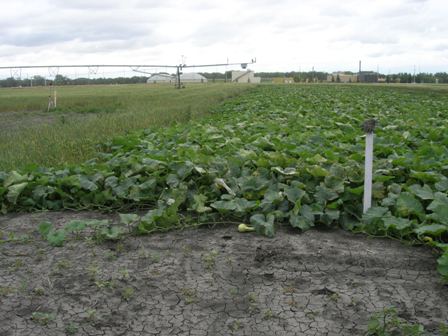
Figure 2: Atlas HP Plants in the Demonstration Plot.
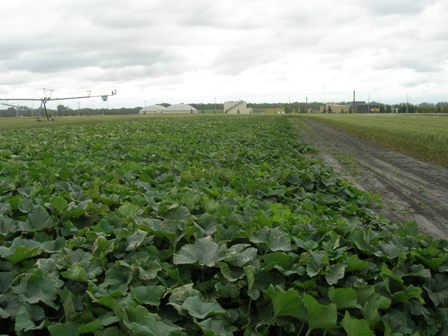
The plot was direct seeded by one of the cooperating producers on May 20, 2010 (Figure 3) with six rows of Ultra HP and two rows of Atlas HP being seeded.
Figure 3: Seeding of Demonstration Plot
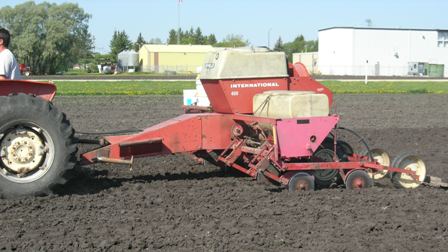
One hundred seedlings were started in the greenhouse so as to be able to fill in any gaps in the plant stand if required. Transplanting and watering-in of the greenhouse grown seedlings took place on June 29, 2010 (Figure 4).
Figure 4: Transplanting and Watering-In of Greenhouse Seedlings into the Demonstration Plot
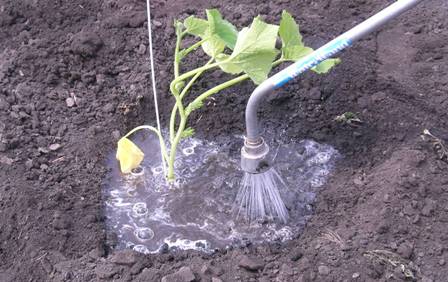
The plot was harvested on September 27, 2010 at 130 days after planting and 90 days after transplanting. Data form the MAFRI Ag Weather station at Portage la Prairie showed was only one light frost (-0.2 °C) prior to harvest on September 19. After July 1, 2010 there were 7 nights prior to harvest where the temperature feel below +5 °C and 26 nights where the temperature fell below 10oC. At temperatures below 10°C (50°F) the plants will stop growing and if the temperature is lower than 5°C. (40°F) for more than a few days maturity can be delayed and/or the plants can be injured. During the commercial harvest, the squash were placed by hand into wooden pallet boxes in the field and the boxes loaded onto a trailer with a skid steer for delivery to a commercial storage (Figure 5).
Figure 5: Harvesting of the Demonstration Plot
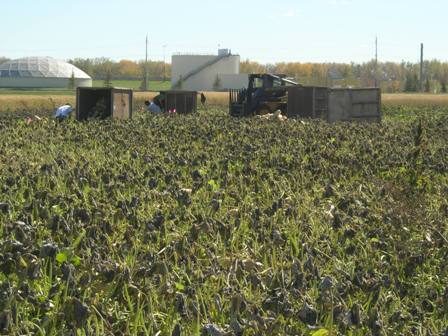
Immediately prior to the plot being harvested a sample harvest was conducted to evaluate the yields of each variety. Four areas were staked off randomly into grids within each variety. Each grid measured 11.5 feet by 11.5 feet or approximately 130 square feet (Figure 6).
Figure 6: Grid Laid Out for Sample Harvesting of Demonstration Plot
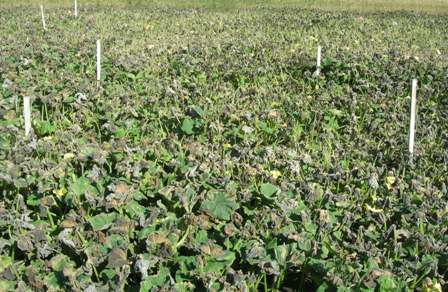
The squash found inside each grid were harvested and the weights recorded (Figure 7).
Figure 7: Weighing Squash from Sample Harvest

The average of the four sample harvests for Ultra HP produced an average yield of 41,350 lbs per acre (46,350 kg/hectare) and for Atlas HP the average yield was 13,850 lbs per acre (15,520 kg/hectare). The cooperating producer who provided the harvesting crew, estimated that the Ultra HP yielded approximately 36,900 lbs per acre (41,400 kg/hectare) and that Atlas HP yielded 13,150 lbs per acre (14,740 kg/hectare). One potential reason for the discrepancy in yields is that during the sample harvest all of the squash in the sampling grid would have been harvested while during the commercial harvest of the remainder of the plot some squash could have been missed by the harvesting crew. For Ultra the average number of squash per hectare was 15, 600 or 6,316 squash per acre. Atlas had 6,000 squash per hectare or 2,429 squash per acre. The average weight of an Ultra HP squash was 6.46 lbs (2.93 kg) and for an Atlas HP squash was 5.70 lbs or 2.60 kg. The harvest results are listed in Table 1.
| Table 1: 2010 Butternut Squash Sample Harvest Results (Sept 27 at 130 D.A.P.) | ||||||||||
| Sample Harvest Ultra HP | Sample Harvest Atlas HP | |||||||||
| Rep 1 | Rep 2 | Rep 3 | Rep 4 | Average | Rep 1 | Rep 2 | Rep 3 | Rep 4 | Average | |
| Yield/Plot (kg) | 54.260 | 62.567 | 56.368 | 58.609 | 57.951 | 15.857 | 20.326 | 24.824 | 16.721 | 19.432 |
| # Squash/Plot | 19.000 | 20.000 | 18.000 | 21.000 | 19.500 | 6.000 | 8.000 | 9.000 | 7.000 | 7.500 |
| Avg Weight Squash (kg) | 2.856 | 3.128 | 3.132 | 2.791 | 2.934 | 2.643 | 2.541 | 2.758 | 2.389 | 2.591 |
| Avg Weight Squash (lb) | 6.283 | 6.882 | 6.889 | 6.140 | 6.455 | 5.814 | 5.590 | 6.068 | 5.255 | 5.700 |
| Yield (kg per Ha) | 43408.0 | 50053.6 | 45094.2 | 46887.2 | 46360.7 | 12685.6 | 16260.8 | 19859.2 | 13376.8 | 15545.6 |
| Yield (lbs per A) | 38727.7 | 44656.8 | 40232.1 | 41831.8 | 41362.1 | 11317.8 | 14507.5 | 17718.0 | 11934.5 | 13869.5 |
| # Squash per Ha | 15200.0 | 16000.0 | 14400.0 | 16800.0 | 15600.0 | 4800.0 | 6400.0 | 7200.0 | 5600.0 | 6000.0 |
| # Squash per A | 6153.8 | 6477.7 | 5830.0 | 6801.6 | 6315.8 | 1943.3 | 2591.1 | 2915.0 | 2267.2 | 2429.1 |
| Grower Estimated Yield 41,380 (kg/ha) | Grower Estimated Yield 14,750 (kg/ha) | |||||||||
| Grower Estimate 36,920 (lbs/A) | Grower Estimated Yield 13,160 (lbs/A) | |||||||||
Yields in Manitoba for commercial acreages of processing butternut squash in the 2010 crop year have been estimated between approximately 16,000 lbs per acre (17,900 kg/hectare) and 40,000 lbs per acre (44,800 kg/hectare). It has been generally accepted that a yield of approximately 20,000 lbs per acre can be achieved. The squash production from this demonstration plot is being used to evaluate the processing method the joint venture plans to use to process the butternut squash and the processability of each variety. The results from the processing portion of this demonstration are proprietary to the joint venture group.
